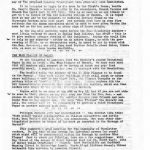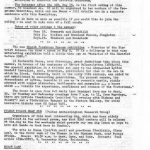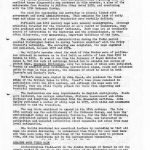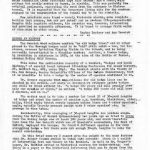Page 1
Stop Press
As this newsletter goes to press, we hear from the Council that HADAS can start excavating at Church End, Hendon. We have been anxiously awaiting this “go ahead” for some months now, and the buildings in the way of the proposed housing development have gradually been demolished.
It is intended to begin in the area by the Clerk’s House, beside St. Mary’s Church – bounded roughly by the churchyard, Church Terrace and Church End (grid ref: TQ 229 896). This is as near as we are likely to get to the centre of the old medieval village of Hendon. It is hoped that we may add to a sequence of medieval pottery found on the Burroughs Gardens site last year; and perhaps even turn up some firm evidence for the Saxon occupation which is said to have given Hendon its name but so far has provided no other sign of Saxon origin.
As the dig will probably begin before the June Newsletter appears – most likely weekend to start is the Spring Bank Holiday, May 26-28 – this is to give members advance warning of its imminence. Anyone who would like to help in any capacity – either as an active digger, or with the processing of finds, or on documentary work, is asked to get in touch with the Hon. Secretary, who will then send them further details about dates, times, etc, as soon as these become available.
The Blue Plaques of Barnet
We are delighted to announce that the Society’s second Occasional Paper is now in print – The Blue Plaques of Barnet. We hope very much that all members will support it by buying at least one copy (and possibly more). A separate order form is enclosed with this newsletter.
The booklet tells the history of the 21 Blue Plaques to be found in the Borough. They mark either buildings which still exist or sites where buildings – such as the Court Leet, the Edgware Turnpike or the pottery kilns of Brockley Hill – once stood. Eleven members did the not inconsiderable research that lies behind the booklet, which was then licked into shape by the editor, Phillipa Bernard.
Copies will be on sale at the AGM on May 15th, but if you are not able to come to that, please order your copy now from the Hon. Sec. – and please do all you can to make the booklet known to your friends and persuade them to buy copies too. The more “Blue Plaques” the Society can sell, the easier it will be financially to produce a third Occasional Paper on another subject next year.
Phillipa Bernard ends her introduction to the booklet like this:
“Such widely varied personalities as William Wilberforce and Little Tich, Anna Pavlova and C. B. Fry are remembered. How many other distinguished persons or houses of interest go unmarked in the Borough of Barnet?”
This suggest a good exercise for the ingenuity of Newsletter readers. Do you know of any famous (or infamous) person (or event) which might well be commemorated with the Borough by another Blue Plaque? Just to start you thinking, here are a few suggestions: Will Hay (lived at the corner of Sunny Gardens Road and Gt. North Way); site of Barnet Wells (mentioned by Pepys); Lord Northcliffe and Cardinal Manning (lived in Totteridge Lane); Marie Lloyd (Golders Green); Oliver Goldsmith (his oak-tree in Lawrence Street).
If you have any contenders to add to that list, please let the Hon. Secretary have your ideas.
Forthcoming Events
Tuesday May 15th, AGM at St. Mary’s Church House, 8.00 p.m. Refreshments followed by the business meeting, followed by two films, about which our Programme Secretary, Liz Holliday, provides these notes: –
Page 2
The Beginning of History – An introduction to the history of the British Isles from the Old Stone Age to the Roman Conquest. The film includes demonstrations of flint chipping, agriculture with stone tools, corn grinding and bronze founding, as well as a complete reconstruction of an Iron Age farmstead.
Timeless Treasure – film of the work of the international centre established by UNESCO in Rome to study the restoration and preservation of histories and artistic treasures.
The Saturday after the AGM – May 19th is the first outing of this summer, to Colchester. It will be organised by two members of the Programme Committee, Colin and Anne Evans – full details are in a separate enclosure with this newsletter. Let us know as soon as possible if you would like to join the outing – we want to make sure of a full coach.
Dates for other outings this summer:
June 16th – Tamworth and Lichfield
July 14th – Wealden and Downland Museum, Singleton
September 15th – Blenheim and Woodstock
The new Church Farm House Museum exhibition – Memories of the District between the Wars – opens on May 5th. It is a follow-up to that very interesting exhibition held a little time ago on “Memories of the District before 1920”.
At Knebworth House, near Stevenage, great junketings take place this summer, in honour of the centenary of Edward Bulwer-Lytton (1803-1873). The special exhibition is a tribute not only to the many-sided Lytton himself (novelist, poet, dramatist, politician) but also to the era in which he lived. Knebworth, built in the early 16th century, was added to and embellished by succeeding generations. Its present owners, the descendants of Lytton, describe it now as “a romantic castle, richly adorned with copper pinnacles, battlements and gargoyles … a house which … recalls the expectancy, confidence and romance of the Victorians”.
The house is open from 2-5 daily (not Mondays) from now to September 30th. On Tuesday and Wednesday evenings from 7 p.m. to 11, from May-Sept. there are private theatricals (entitled “An evening with Dickens and Bulwer”) and a Pickwickian Banquet in the Picture Gallery, for which inclusive tickets cost £5 (plus VAT).
Fulham Palace Moat Dig
Organisers of this most interesting dig, which has been widely publicised in the national press, say that HADAS members will be welcome at the dig in the few weekends which precede our own dig (when we hope to have all hands on deck here in Hendon).
The site is Roman (3rd/4th century) and pre-Roman (Neolithic,?Iron Age) on the North bank of the Thames in the Bishops Park, near Putney Bridge. Hours: 10.30 a.m. to dusk, Sats. and Suns. Contact Paul Arthur.
Roman Lamp
The March Newsletter (no 25) gave details of a Roman lamp found near an entrance to Copthall Playing Fields. Since then, a member of HADAS has walked over the area with the finder, in order to pinpoint the precise spot.
As a result, we can now give you a 4-figure grid reference for this find, slightly different from the original reference provided by the finder. The new reference is: TQ 2329 9030. Some members, we know, plot sites and find-spots on a map of the Borough, and may like to note this new reference and to alter the earlier one on their maps.
Page 3
Maps as aid to historical research
Liz Holliday sends us this report on Dr, Helen Wallis’s lecture, which ended the Society’s winter season:
Members not able to attend the meeting on April 10th missed a fine opportunity to hear Dr. Wallis, Superintendent of the British Museum Map Room, outline the use of maps as an aid to historical research.
Dr. Wallis presented her talk chronologically, beginning with the earliest known diagrammatic map produced in this country, a plan of the waterworks from Wormley to Waltham Abbey dated 1220, and concluding with the 1794 Ordnance Survey.
The need for map-making and surveying is closely linked with government and civil administration. This explains the lack of early maps and plans as most estate boundaries were verbally defined.
15th and 16th century maps were usually scenographic. Although primarily intended for the traveller or as a record of boundaries, they were produced with an artistic influence. Such maps are an invaluable source of information to the historian and the archaeologist, as they often illustrate, very accurately, important buildings of the time.
The expansion of civil administration during the Tudor period enabled Christopher Saxton to survey “certain counties” with the Privy Council’s authority. The surveying was completed, the maps engraved and published, between 1573 and 1579.
Dr. Wallis’s remarks about the work of John Norden were of particular interest to members as he died (with an estate of less than £30) in Hendon in 1607. He was at one time Surveyor of Royal Estates to James I, but his lack of patronage forced him to abandon his series of pocket maps, Speculum Britanniae, only two volumes of which were published. Norden is credited with introducing conventional signs, roads and reference grids to maps in this country, the absence of which he noted in both Saxton’s and Camden’s work.
Norden’s maps were copied by John Speed, who produced the first atlas of the British Isles in 1611. Speed’s town plans remained in publication until the late 18th century, and although his maps were not original, they are still highly prized for their fine engraving and beautiful decoration.
The Restoration saw many improvements in English cartography. Roads were included, new surveys undertaken, distance measurement was standardised and longitude established from the Greenwich meridian. John Ogilby published a series of strip maps in 1675, with hills and landmarks included to aid the traveller.
The map trade continued to expand in the 18th century. The late 18th century saw the establishment of Ordnance Survey, and here the archaeologist of today is particularly fortunate, for the Duke of Richmond, who patronised several cartographers at this time, was interested in antiquities and included information about monuments and sites from may local antiquaries.
Dr. Wallis concluded her excellent lecture by reminding us reminding us that all maps are social documents; to understand them fully the user must know why they were made, the limitations of the techniques used to produce them, and the limitations set by the cartographers themselves.
Scratch Wood Field Walk
Archaeological field-work in the London Borough of Barnet is not the simple matter it can be on the open spaces of the Yorkshire moors or the Sussex Downs: but even in built-up areas like ours, there are some open spaces. The Research Committee has long wanted to start exploring them for possible evidence of the past, in the form of features and artefacts.
Some months ago, Ann Trewick and a group of members investigated some open areas in Totteridge; and on Sunday April 29th, 11 members made a preliminary examination of Scratch Wood.
Page 4
The origins of the ownership of the wood are obscure. At one time it appears to nave been part of a parcel of land granted to the Knights of St. John of Jerusalem. It lies close to the line of Grimsdyke; Grimsgate (now Barnet Gate) is nearby.
The wood shows obvious signs of landscaping. The banks of ‘rides’ can be distinguished and the areas of rhododendron shrubberies and other species uncommon in natural British woodland indicate landscaping. This work may have destroyed features.
An interesting old hedge line, bounded in part by a channel with a brick foundation (some Victorian type blue bricks) and a fence, still evident but mostly rotted and burnt, is visible. This was probably the original enclosure, separating the wood from the entrance to the Elstree tunnel. It is suggested that the temporary living site for the workmen engaged in the construction of the tunnel may be in the vicinity.
Few artefacts were found – merely Victorian sherds, some compete bottles (not modern, but not yet dated) and an ox bone (?dog deposited). Despite this negative evidence, the exercise was, however, interesting and provided an enjoyable afternoon. It is hoped to arrange field walks of this kind in other areas.
Hedges in History
The Scratch Wood walkers mention “an old hedge line”; and at other places in the Borough hedges said to be old still exist – one, for instance, crosses Lyttleton Playing Fields in the Suburb, and is being currently investigated by a Finchley member; another, a famous hedge, by tradition existing in 1471, at the time of the Battle of Barnet, crosses Hadley Golf Course.
This makes the publication recently of a booklet, “Hedges and Local History”, of special local interest (Standing Conference for Local History, 26, Bedford Square, WC1, price 50p). The booklet starts with the theory of Dr. Max Hooper, Senior Scientific Officer of the Nature Conservancy, that it is possible to date a hedge by the number of species contained in it.
Dr. Hooper suggests that map-evidence for old hedge lines can be checked by his method, and where no documentary evidence exists, hedges can still be dated without it. “A hedge 100 years old will usually have only one species of shrub”, he writes; “a hedge 200 years old will have 2 species, and so on”.
The method used is to take a number (at least 3) of 30-yard lengths of hedge and count the number of species e.g. hawthorn, blackthorn, elder, holly, field maple (which rarely appears unless there are 4 other species), apple, spindle (rarely present except with 6 other species), etc. An average is then taken.
Incidentally, this averaging of 30-yard lengths can produce snags. During the Battle of Barnet Quincentenary two years ago we tried to prove that the Hadley Hedge was at least 500 years old, and could therefore have been the one beneath which one of Warwick’s commanders, the Earl of Oxford, deployed his troops. We found 6 different species in the very straggling hedge – but there were not enough 30-yrad lengths to make the result convincing.
In this brief summary I cannot give due weight to the many factors that Dr. Hooper thinks should be taken into account: there is a wealth of interesting fact and theory in the booklet. As well as Dr. Hooper’s paper, Dr. Hoskins writes on historical source for hedge dating; and there is a paper on the historical inferences that can be drawn from the incidence in hedges of the two major types of hawthorn and their hybrids.
Finally, there is an article by D. E. Allen on the unexpected topic of dating brambles in the Highland Zone. In the Isle of Man Mr. Allen has dated hedge-banks back to prehistoric times by means of the diversity of species of blackberries they contain.
Note: From July 25 – August 1, Dr. Hooper will direct a course on History in the Hedgerow at Flatford Mill Field Centre, East Bergholt, Colchester. Fee: approx. £20. Enquiries to the Warden of the Centre.





